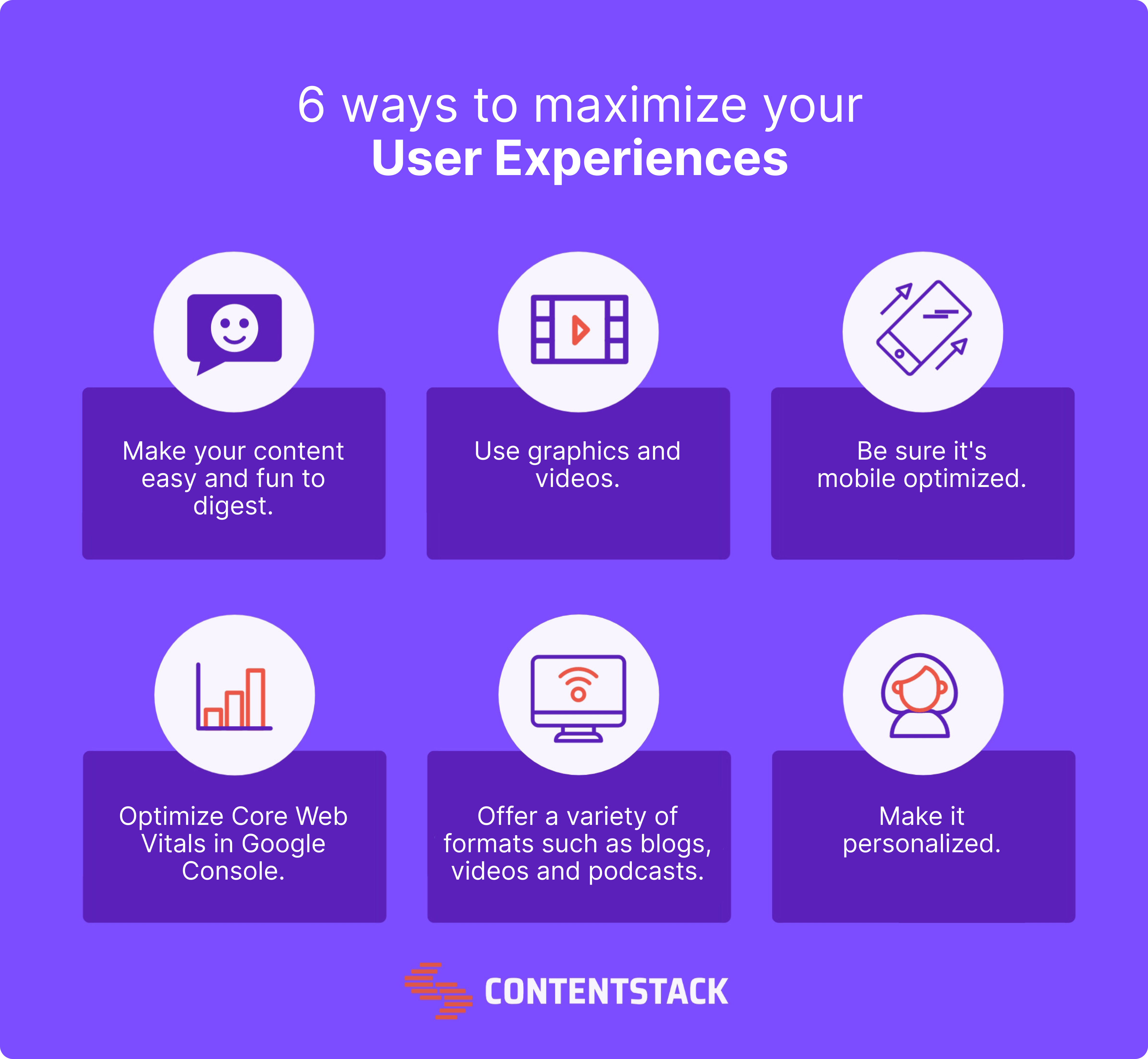The ultimate guide to content experience
There's no question that content is king in the marketing world. But what good is great content if it's not properly presented to your audience? In this ultimate guide to content experience, we'll take you through what content experience is and why it's important to get it right.
What is content experience, and why should you care?
If you care about your customer, you care about understanding content experience.
According to Spiceworks, Content experience is “the experience of accessing, consuming and engaging with and responding to a stream of brand content across diverse devices, platforms, and channels, through the journey from prospect to customer.”
Great content experiences should be relevant, personalized, timely, consistent, and convenient and engage and delight your prospects, leading them to conversion. This may sound like a tall order, but it is vital to put yourself in your audience's shoes and understand what they want to hear and how they would like to access their information.
Of course, enterprises are constantly putting out content in a wide variety of formats, but are they thinking of the impact their content is having on the customer, or are they just sending out the messages they want to broadcast?
Each touchpoint is important and can either draw customers in or push them away from competitors. We all have experience engaging with a business and then finding the communications are, at best, disappointing and, at worst, irritating. Is the tone correct? Is your name spelled correctly? Is the frequency of the marketing too much or too little? There are many ways to make customers happy or unhappy; these emotions make up the customer experience. This decides whether or not the customer will keep doing business with a company or turn to its competitors.
The enterprises that prioritize content experience management are the ones that win your attention and get recommended to your friends and family. And that’s the goal: to stand out from the crowd and turn your prospects into customers and fans of your brand. If your customers are fans, they will become loyal ambassadors, spreading the word, which is the holy grail.
How does content marketing differ from content experience?
Content marketing is usually defined by a three-pillar system, including creation, distribution, and insights. This doesn’t take a significant pillar into account: experience. Content experience is a more holistic approach than just creation, consumption, and measurement. It is designing a journey and thinking about how the prospect would like you to talk to them, what they would like to find out, and giving it to them in their favorite format. Content marketing requires a bird’s eye view of all your marketing content and a strategy. Without a strategy, your content marketing will be scattergun, and although some of it might resonate, it’s too much of a gamble to rely on chance.
The challenges of creating content experiences
Content experience refers to how content is presented to users on a given platform and how it is received. CMS and experience platforms provide different content experiences, each with advantages and disadvantages.
One challenge of content experience is that it can be difficult to structure content in a way that is easy for users to consume. There is a diverse range of devices, platforms, and channels, each of which needs to offer a frictionless experience. Testing on various devices with tools such as BrowserStack that give a real-time simulation of devices and browsers can be helpful.
Content experiences can also be frustrating if they are not well-designed or do not meet the user's needs. The prospect will quickly notice poorly designed engagement tactics or a lack of personalization. To avoid this, you must understand the different buyer personas in your target audience and tailor your content to each of them in a suitable format for each persona.
Lastly, the perennial challenge is determining ROI. Marketers need to be able to see what is working and use these lessons for future campaigns.
How to create great content experiences
Creating great content experiences takes strategy and planning. You need to identify who you’re speaking to and put yourself in their shoes. And once that’s done, you can start getting creative. In a crowded marketplace, it pays to stand out and be remembered.
First, make your content easy and fun to digest. You don’t want your audience to work to understand what you’re offering. Use a variety of formats, including graphics, videos, podcasts, blogs, emails, and more, because different people respond differently. Ensure it is mobile optimized because there will likely be a mobile touchpoint somewhere, even if it is not for the entire journey. Make sure your website is fast and responsive, as this is something Google measures and takes into account (see Core Web Vitals). A speedy website is more likely to keep customers engaged than a sluggish one.
And lastly, ensure your content is personalized, not just with the customers’ names but in thinking about what is relevant to them. What are the benefits to the user? Is it useful and informative? Is the information trustworthy and correct? If it ticks those boxes, you’re giving your prospect what they want and need.

So, what steps must you take to create highly engaging content experiences? As with most marketing, you must research and lay the foundations before you can get creative. Gartner finds that “30% of organizations have established their customer journey maps, but struggle to use them effectively.” The foundational CX elements must be in place, and actionable, accurate customer journey maps should be created. Once you have prepared the groundwork and created the engaging content, it needs to be managed, updated, refreshed, distributed and lastly, analyzed. After all, there is no point in creating great content and not learning from it.
Five steps to creating content experiences
- Content audit
- Content creation
- Content management
- Content distribution
- Content analytics
Examples of Content ExperiencesThere are many ways to use content to communicate with your audience and draw them along the buying journey. B2B businesses often need to present long-form technical content, so the challenge is to make it sticky, interesting, and useful.
Here are four of the most common ways content experience is used by B2B companies:
- White papers: Widely used as reference material, these can easily be linked to and shared.
- Digital magazines and brochures: These formats are versatile and engaging and offer easy-to-measure interaction such as reading time, sharing on social media, and more.
- Digital reports: The challenge with large amounts of data is presenting it clearly, accurately, and in a format that can be shared easily.
- Email and interactive newsletters: These are among the most cost-effective and widely used methods of interacting with prospects and customers and can support video, embedded forms, smart CTAs and personalization.
Common mistakes in creating content experiences
As with any complex and meaningful marketing activity, there are plenty of potential pitfalls to be aware of when creating content experiences. These mistakes are easy to avoid with a good content experience strategy:
- Poor personalization
- Poor quality messaging and graphics
- Not planning the whole content journey
- Overlooking distribution
- Neglecting accessibility
- Slow user experience
- Not optimizing for mobile devices
- Not setting up tracking and reporting
The future of content experience: How to stay ahead of the curve
Writing on Forbes.com, Nathaniel Hunter said he believes “the future of content will be digitally defined in a more immersive, touchable and interactive experience.” We know the speed of change is increasing, and more possibilities are entering the race with every technological advance.
Multiexperience will evolve in the digital world, and according to Joseph Dickerson, “AR, VR, and mixed reality experiences will become a more accepted part of how people engage with technology.”
All content experience creators must embrace new technologies on the market and continue testing new and immersive experiences.
What tools do you need to create great content experiences?
“MACH” is a term for modern technology that is:
- Microservices-based
- API-first
- Cloud-native
- Headless
A MACH headless CMS is the ideal foundation for an omnichannel content experience because, at its core, a headless CMS separates content creation and management from content formatting and distribution.
API technology enables the front-end display layer to communicate with the back-end content repository without intertwining their functionality.
Thanks to this modular architecture, marketing teams can create content once, reformat it, and republish it across various platforms, devices, and channels. The flexibility is endless. In addition, this means marketers can plug in microservices such as best-in-class solutions to upgrade the content experience — no expensive, slow development process needed.
See a content experience platform in action
Ready to level up your content experience marketing? Request a demo of the Contentstack platform and see why top brands are choosing our content experience platform.
